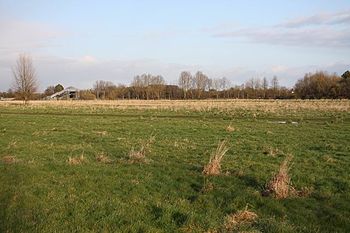Stourbridge Common: Difference between revisions
Created page with 'right|thumb|350px|Stourbridge Common [[File:Stourbridge Common - geograph.org.uk - 1061184.jpg|right|thumb|250px|Stourb…' |
|||
| Line 42: | Line 42: | ||
[[Category:Cambridge]] | [[Category:Cambridge]] | ||
[[Category:Commons | [[Category:Commons in Cambridgeshire]] | ||
Latest revision as of 20:36, 19 May 2014


Stourbridge Common covers a great many acres along the south bank of the River Cam stretching west of Cambridge towards Fen Ditton, with Chesterton on the opposite bank.
The common is a broad, green space, a contrast even to the light urbanity of the city it touches, but close in to the city: only a single stretch of modern developments separates it from Midsummer Common. The common has however been cruelly riven in twain by a railway line and an ugly rail bridge over the Cam, and is overstepped by the A14, but there interruptions apart it is an important place of nature.
Half of the common is a local nature reserve.
Stourbridge Fair
From the thirteenth to the nineteenth century the common was the location of the Stourbridge Fair, which at its height was one of the greatest trade fairs in the world, compared by one contemporary to that of Nizhny Novgorod.
In 1199, King John granted the Leper Chapel at Steresbrigge in Cambridge dispensation to hold a three-day fair to raise money to support the lepers. The first such fair was held in 1211 around the Feast of the Holy Cross (14 September) on the open land of Stourbridge Common alongside the River Cam. The position of common along with the river allowing barges to travel up the Cam from The Wash, and as it was near an important road leading to Newmarket, this meant that the fair was accessible to a large population. Despite its proximity to Cambridge, the charter prohibited anyone from imposing taxes on the commerce there.
During its history the fair was variously spelled "Stir-Bitch", "Stirbitch" and "Sturbridge", with its name derived from the "Steer Bridge" (which is to say a bridge for oxen), where the road to Newmarket crosses a small river that enters the Cam just to the east of the common (the name "Sture" or "Stour" now given to this river is a back-formation).[1]
Isaac Newton visited the fair as a young undergraduate and bought a copy of Euclid which spurred his interest in mathematics.
In the late eighteenth century, the popularity of the fair began to decline, partly due to the arrival of canals and improved roads leading to the decline in the importance of rivers as a means of navigation. The fair only lasted a fortnight, and the amount of income it generated for the city had fallen. By the nineteenth century, the fair served more as a means of entertainment than being of economic importance, now only a few days in length. As the Victorian town grew, the common became surrounded by poor housing, and the rich visitors became disinclined to visit a potentially dangerous area. The Midsummer Fair, on the other hand, was in a more convenient central location and the Stourbridge Fair fell out of favour.

Stourbridge Fair continued until it was held for the final time in 1933. On this occasion the fair was opened by the Mayor of Cambridge, Florence Keynes (mother of John Maynard Keynes), "in the presence of a couple of women with babies in their arms and an ice-cream barrow."
Daniel Defoe visited the fair and wrote at length of it in his Tour through the whole island of Great Britain, stating:
| “ | "this fair, which is not only the greatest in the whole nation, but in the world; nor, if I may believe those who have seen the mall, is the fair at Leipzig in Saxony, the mart at Frankfort-on-the-Main, or the fairs at Nuremberg, or Augsburg, any way to compare to this fair at Stourbridge." | ” |
He described the huge variety of merchandise, with stalls including "goldsmiths, toyshops, brasiers, turners, milliners, haberdashers, hatters, mercers, drapers, pewterers, china-warehouses, and in a word all trades that can be named in London."[2][3]
Modern Fair

In recent years the Stourbridge Fair has been revived in a form, as an entertainment and celebration of history.
The National Trust has published a craving to acquire the common to incorporate into its "Great Fen Project", bringing the project all the way into the city, though whether the intent is to block the drainage channels and flood the common with marshwater is unclear.
Outside links
References
- ↑ Cam, Helen M. (1959). "The City of Cambridge : Economic History : Fairs". in Roach, J. P. C. (ed.). Victoria County History of Cambridgeshire, vol. 3. pp. 92–95. ISBN 0-7129-0243-0.
- ↑ Daniel Defoe (1724). Tour through the whole island of Great Britain, Volume 1, Letter 1.
- ↑ "Defoe - Tour through Great Britain: Stourbridge Fair". stirbitch.com. http://www.stirbitch.com/cantab/resources/stourbridge_fair_defoe.html.